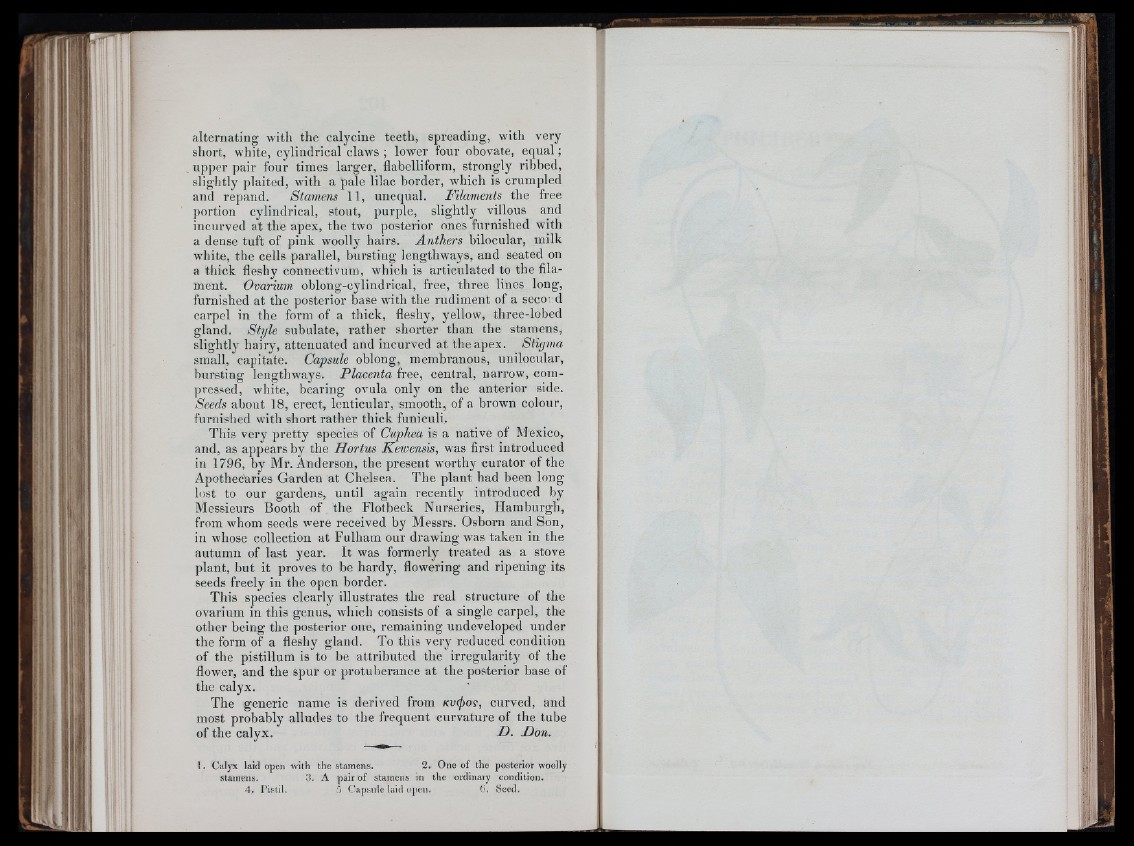
:■ if 1'
I'
alternating with the calycine teeth, spreading, with very
short, white, cylindrical claws ; lower four obovate, e q u a l;
. upper pair four times larger, flabelliform, strongly ribbed,
slightly plaited, with a pale lilac border, which is crumpled
and repand. Stamens 11, unequal. Filaments the free
portion cylindrical, stout, purple, slightly villous and
incurved at the apex, the two posterior ones furnished with
a dense tuft of pink woolly hairs. Anthers bilocular, milk
white, the cells parallel, bursting lengthways, and seated on
a thick fleshy connectivum, which is articulated to the filament.
Ovarium oblong-cylindrical, free, three lines long,
furnished at the posterior base with the rudiment of a seco'd
carpel in the form of a thick, fleshy, yellow, three-lobed
gland. Style subulate, rather shorter than the stamens,
slightly hairy, attenuated and incurved at the apex. Stigma
small, capitate. Capsule oblong, membranous, unilocular,
bursting lengthw’ays. Placenta free, central, narrow, compressed,
wdiite, bearing ovula only on the anterior side.
Seeds about 18, erect, lenticular, smooth, of a brown colour,
furnished with short rather thick funiculi.
This very pretty species of Cuphea is a native of Mexico,
and, as appears by the Hortus Kewensis, was first introduced
in 1796, by Mr. Anderson, the present worthy curator of the
Apothecaries Garden at Chelsea. The plant had been long
lost to our gardens, until again recently introduced by
Messieurs Booth of the Flotbeck Nurseries, Hamburgh,
from whom seeds were received by Messrs. Osborn and Son,
in whose collection at Fulham our drawing was taken in the
autumn of last year. It was formerly treated as a stove
plant, but it proves to be hardy, flowering and ripening its
seeds freely in the open border.
This species clearly illustrates the real structure of the
ovarium in this genus, which consists of a single carpel, the
other being the posterior one, remaining undeveloped under
the form of a fleshy gland. To this very reduced condition
of the pistillum is to be attributed the irregularity of the
flower, and the spur or protuberance at the posterior base of
the calyx.
The generic name is derived from K v f o s , curved, and
most probably alludes to the frequent curvature of the tube
of the calyx. D . Don.
1. Ciilyx kid open with the stamens. 2. One of the posterior woolly
stamens. 3. A pair of stamens in the ordinary condition.
4. I’i.stil, 5 Capsule laid o|)en. (i. Seed.